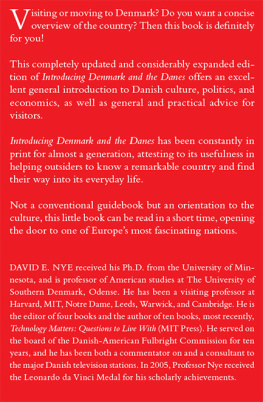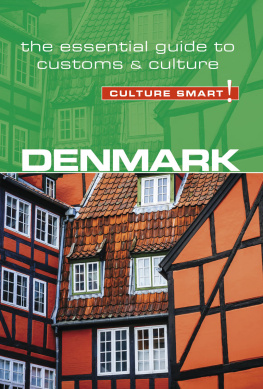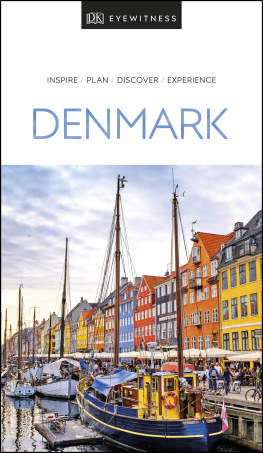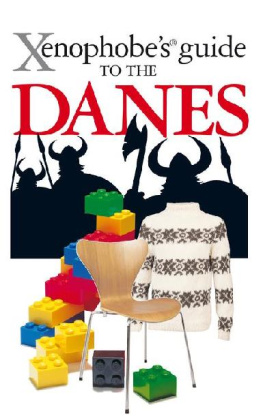David E. Nye
Introducing Denmark and the Danes
a two hour briefing
Introducing Denmark and the Danes
David E. Nye and University Press of Southern Denmark 2013
Layout by Narayana Press
Cover design by Anne Charlotte Mouret, UniSats ApS
ISBN (digital version): 978-87-7674-720-6
ISBN (printed version): 978-87-7674-128-0
Revised 5th edition
Photographs in the book:
Cover photograph Polfoto
Photographs pages Polfoto
Photographs pages Scanpix
Photograph page Sund & Blt
Photograph page by kind permission of Her Majesty the Queen of Denmark and Bjrn Nrgaard
Photograph page Steen Larsen
Photograph page Morten Marboe
Photograph page Vestas Wind Systems A/S
Photographs pages The Copenhagen Post
Drawings pages Bjerne Johansen
Map page Birger Bromann
Electronic, mechanical, photographic or other reproduction of this book or portions of it is not permitted under Danish copyright laws.
University Press of Southern Denmark
Campusvej 55
DK-5230 Odense M
Denmark
www.universitypress.dk
Table of Contents

This little book began as one in a series of short works designed by FUHU (the Danish Society for the Advancement of Business Education) to introduce students to nations that they would visit in the course of their studies.
The rest of the series was written by Danes with long experience living abroad, but as a foreigner long resident in Denmark, I was asked to write the volume on Denmark, which first appeared in 1991 and has sold briskly ever since.
This considerably expanded and completely updated edition is for anyone who wants to get oriented to Denmark. It points out things that are so obvious to the Danes themselves that they might not think it necessary to explain them.
It is not a conventional guidebook, but falls somewhere between scholarship, journalism, and personal opinion. It is scholarly in the sense that all names, dates, and statistics are as accurate as possible. It is journalistic in that the writing is uncomplicated and generalizes about a large subject in a small space.
It can only be a curiosity to Danes, but it introduces outsiders to a remarkable country and helps them to find their way into its culture.


In 1988 a 12 year-old Danish girl went to the United States with her parents for a year and attended the local school. Early in the first term, the teacher asked her to show the class where she came from, using a map in the history book. She turned to a map of Europe, but much to her shock, Denmark was not there. Some of the islands were vaguely sketched in, but a reader could not tell if they were part of Sweden or Germany. She was too amazed to be embarrassed, and pointed out the books error with some emphasis. She had just learned that Danes abroad often must contend not so much with stereotypes as with ignorance.
Most people at least know where France, Japan, China, or Germany are on a map, and most people have a few ideas about what these nations are like. Denmark is far less known, and many have somewhat diffuse ideas about it, like an island only glimpsed through the mist and fog. Some assume that Scandinavians are much alike, mixing together Swedes, Norwegians, and Danes in a hazy vision of blond people living in a snow-bound welfare state in northern Europe.
For those who know it, however, Denmark is quite distinct from its Scandinavian neighbors. It has a long history, and at least until c. 1630 it was one of the great European powers. Yet, today it is a small country, and visitors may perhaps be forgiven for knowing little about it on arrival. Some people have ideas about it that, like the American textbook, are entirely incorrect. Presumably you know that Copenhagen is not the capital of Sweden and that the language of Denmark is neither Dutch nor Denmarkese. You may rightly suspect that most of that famous pornography is sold to tourists, and you probably know that Danes are seldom brooding Hamlets who act as if they were suffering an existential crisis in an Ingmar Bergman film. (Besides, Bergman is Swedish.) But can you sort out true from false in the following statements?
The best time to visit is July, when one can enjoy the midnight sun.
Like Norway, Denmark often wins gold medals at the winter Olympics.
Denmark is a predominantly agricultural country.
Its chief exports are bacon, cheese, butter, and other foodstuffs.
Like the other Nordic countries, Denmarks hilly terrain and cold winters make it ideal for skiers and skaters.
Denmark is a welfare state that controls virtually all services, such as the telephone company.
All of these statements are false. Denmark is mostly flat, and the highest point is only 568 feet above the sea. The second highest elevation is but 482 feet high, even if the Danes call it Heaven Mountain (Himmelbjerget). Obviously, compared to most nations, Denmark has only hills, and cannot build a proper downhill ski resort. The country does not even send a team to the winter Olympics, although individuals do participate, some coming from Greenland. Furthermore, Denmark is too far south to enjoy the midnight sun or to get certain, regular snowfall.
The major winter sports other than European football are played indoors: handball and badminton. The temperate climate does make it an ideal agricultural nation, justly famous for bacon, cheese, and milk products, and two-thirds of the land is used for farming. For seventy years, however, the country has been predominantly industrial, and industrial goods and services make up the lions share of exports. Denmark has a mixed economy, with few state-run businesses. The telephone service is private, with several competing companies, and although most other services are public, they are not always free. If you failed parts of this informal test, read on.

Not much snow in Denmark.
Next page
















